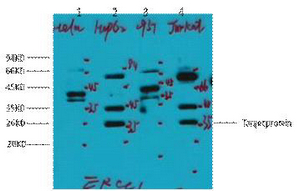STING (Phospho Ser366) rabbit pAb
- 货号:YP1684
- 应用:WB
- 种属:Human;Mouse;Rat
- 简介:
- >>NOD-like receptor signaling pathway;>>RIG-I-like receptor signaling pathway;>>Cytosolic DNA-sensing pathway;>>Shigellosis;>>Human cytomegalovirus infection;>>Herpes simplex virus 1 infection;>>Human immunodeficiency virus 1 infection;>>Coronavirus disease - COVID-19
- 基因名称:
- TMEM173 ERIS MITA STING
- 蛋白名称:
- STING (Phospho-Ser366)
- 免疫原:
- Synthesized peptide derived from human STING (Phospho-Ser366)
- 特异性:
- This antibody detects endogenous levels of STING (Phospho-Ser366) at Human, Mouse,Rat
- 组成:
- Liquid in PBS containing 50% glycerol, 0.5% BSA and 0.02% sodium azide.
- 来源:
- Polyclonal, Rabbit,IgG
- 纯化工艺:
- The antibody was affinity-purified from rabbit serum by affinity-chromatography using specific immunogen.
- 储存:
- -15°C to -25°C/1 year(Do not lower than -25°C)
- 其他名称:
- Transmembrane protein 173 (Endoplasmic reticulum interferon stimulator) (ERIS) (Mediator of IRF3 activation) (hMITA) (Stimulator of interferon genes protein) (hSTING)
- 背景:
- This gene encodes a five transmembrane protein that functions as a major regulator of the innate immune response to viral and bacterial infections. The encoded protein is a pattern recognition receptor that detects cytosolic nucleic acids and transmits signals that activate type I interferon responses. The encoded protein has also been shown to play a role in apoptotic signaling by associating with type II major histocompatibility complex. Mutations in this gene are the cause of infantile-onset STING-associated vasculopathy. Alternate splicing results in multiple transcript variants. [provided by RefSeq, Sep 2014],
- 功能:
- function:Acts as a facilitator of innate immune signaling. Able to activate both NF-kappa-B and IRF3 transcription pathways to induce expression of type I interferon (IFN-alpha and IFN-beta) and exert a potent anti-viral state following expression. May be involved in translocon function, the translocon possibly being able to influence the induction of type I interferons. May be involved in transduction of apoptotic signals via its association with the major histocompatibility complex class II (MHC-II). Mediates death signaling via activation of the extracellular signal-regulated kinase (ERK) pathway.,PTM:Phosphorylated on tyrosine residues upon MHC-II aggregation.,subunit:Associates with the MHC-II complex (By similarity). Interacts with DDX58/RIG-I, MAVS/VISA and SSR2.,tissue specificity:Ubiquitously expressed.,
- 细胞定位:
- Endoplasmic reticulum membrane ; Multi-pass membrane protein . Cytoplasm, perinuclear region . Endoplasmic reticulum-Golgi intermediate compartment membrane ; Multi-pass membrane protein . Golgi apparatus membrane ; Multi-pass membrane protein . Cytoplasmic vesicle, autophagosome membrane ; Multi-pass membrane protein . Mitochondrion outer membrane ; Multi-pass membrane protein . Cell membrane ; Multi-pass membrane protein . In response to double-stranded DNA stimulation, translocates from the endoplasmic reticulum through the endoplasmic reticulum-Golgi intermediate compartment and Golgi to post-Golgi vesicles, where the kinase TBK1 is recruited (PubMed:19433799, PubMed:30842659, PubMed:30842653, PubMed:29694889). Upon cGAMP-binding, translocates to the endoplasmic reticulum-Golgi interme
- 组织表达:
- Ubiquitously expressed. Expressed in skin endothelial cells, alveolar type 2 pneumocytes, bronchial epithelium and alveolar macrophages.



